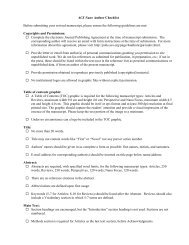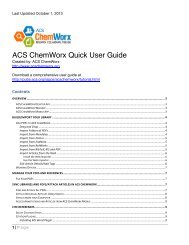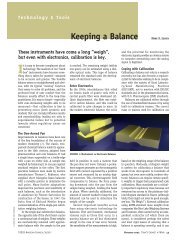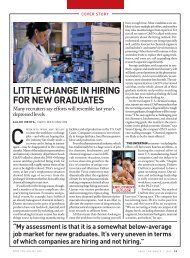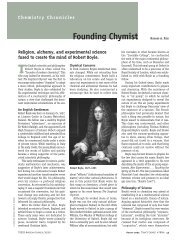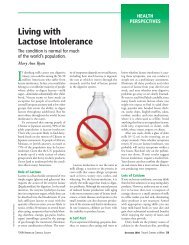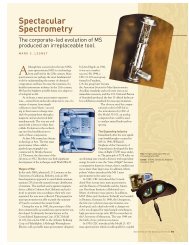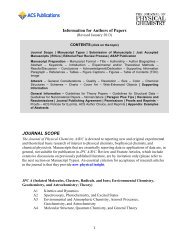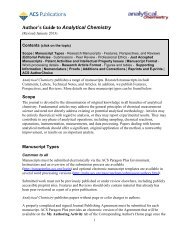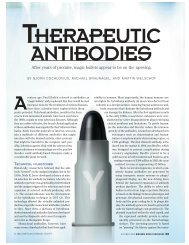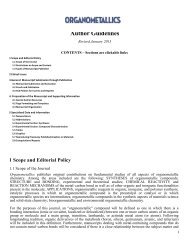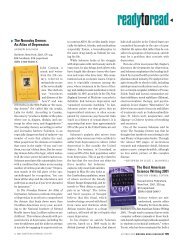TECHNICAL PROGRAM - American Chemical Society Publications
TECHNICAL PROGRAM - American Chemical Society Publications
TECHNICAL PROGRAM - American Chemical Society Publications
You also want an ePaper? Increase the reach of your titles
YUMPU automatically turns print PDFs into web optimized ePapers that Google loves.
CHED <strong>TECHNICAL</strong> <strong>PROGRAM</strong><br />
9:05 375. Interdisciplinary learning experience<br />
in biophotonics. A. Gericke,<br />
R. J. Twieg, J. T. Gleeson, J. R. Stalvey,<br />
D. kline<br />
9:30 376. Measuring the effect of an instrument-intensive<br />
curriculum on student<br />
critical thinking skills at Boise State University.<br />
S. E. Shadle, D. L. Warner,<br />
E. C. Brown, M. H. Towns<br />
9:55 Intermission<br />
10:05 377. BRAIDing together the science<br />
disciplines. R. Sweeder<br />
10:30 378. Five years of change in the<br />
MTSU general education STEM curriculum:<br />
Where we began, where we are now<br />
and where we are going.<br />
J. M. Iriarte-Gross, M. R. Weller,<br />
K. Greer<br />
10:55 Intermission<br />
11:05 379. ChemCompanion, a digital text<br />
for the first-year college chemistry<br />
course. S. Wood, L. Seawright, G. Trevor,<br />
D. Macfarlane, S. Stacey<br />
11:30 380. ChemQuery as a formative assessment<br />
instructional strategy for Chem<br />
1. K. Scalise, A. Stacy, M. Douskey<br />
11:55 Concluding Remarks<br />
Section C<br />
Seaport Hotel<br />
Seaport Ballroom A<br />
Research in <strong>Chemical</strong> Education<br />
G. Bhattacharyya, Organizer<br />
S. Sandi-Urena, Presiding<br />
8:30 Introductory Remarks<br />
8:35 381. Efficacy of community college student<br />
participation in STEM research programs.<br />
C. J. Foley, N. A. Leonhardt<br />
8:55 382. Measuring student cognition during<br />
the learning of undergraduate organic<br />
chemistry. S. Schelble, K. Knaus<br />
9:15 383. Generating classroom cognition<br />
profiles during the assessment of learning<br />
of chemistry. K. Knaus, S. Schelble<br />
9:35 384. Representational competence in<br />
organic chemistry: Function to structure.<br />
H. Brinson, G. Bhattacharyya<br />
9:55 Intermission<br />
10:10 385. Interpretations of atomic representations:<br />
A comparative study of students<br />
and teachers. I. I. Salame,<br />
D. A. Krauss, S. Sarowar, S. Begum<br />
10:30 386. Results from Independent Laboratory<br />
Access for the Blind (ILAB) mainstream<br />
high school project years 1-3.<br />
C. A. Supalo, T. E. Mallouk,<br />
H. D. Wohlers, W. S. Carlsen<br />
10:50 387. Teachers’ perceptions of research-based<br />
labs in a high school<br />
chemistry curriculum. M. Pilarz,<br />
K. S. Kingery, G. C. Weaver<br />
11:10 388. Chemistry outreach programs:<br />
Can we tell if they help students learn?<br />
S. Burris, L. Pesterfield, E. Dumeyer<br />
Section D<br />
Seaport Hotel<br />
Seaport Ballroom B<br />
Where Goeth the Chemistry Textbook<br />
J. Reeves, Organizer<br />
D. Exton, Organizer, Presiding<br />
8:30 Introductory Remarks<br />
8:35 389. Where goeth our textbooks.<br />
J. Reeves, D. Exton<br />
8:55 390. Choices for higher education publishers.<br />
K. A. Peterson<br />
9:15 391. Chemistry textbooks: Where have<br />
we been? Where are we going? J. Kotz<br />
9:35 Intermission<br />
9:50 392. Perspectives of a wheeler-dealer<br />
in the textbook world. P. Kelter<br />
26–TECH<br />
‡ Cooperative Cosponsorship<br />
10:10 393. One view of general chemistry<br />
textbook evolution and the textbook of<br />
the future. R. A. Pribush<br />
10:30 394. Chemistry, life, the universe and<br />
everything: A research-based general<br />
chemistry curriculum. M. Cooper,<br />
M. W. Klymkowsky<br />
WEDNESDAY AFTERNOON<br />
Section A<br />
Seaport Hotel<br />
Plaza Ballroom A<br />
Teaching Science to Elementary Teachers<br />
L. Hogue, Organizer, Presiding<br />
1:30 Introductory Remarks<br />
1:35 395. Critical components of a college<br />
chemistry course for pre-elementary education<br />
majors: The evolution of a course.<br />
M. D. Duerst<br />
1:55 396. How do we teach elementary<br />
teachers. M. W. Moy<br />
2:15 397. Claims, evidence, and the scientific<br />
method. M. Sarquis, L. Hogue<br />
2:35 398. Professional development: Strategies<br />
and activities for pre-service and inservice<br />
teachers. D. A. Katz<br />
2:55 Intermission<br />
3:10 399. How a simple chemical analysis<br />
created a million jobs. D. Hicks<br />
3:30 400. Science in 3D: Drawing, dance,<br />
and drama. Z. M. Lerman<br />
3:50 401. Toys in the elementary classroom.<br />
J. L. Sarquis<br />
4:10 402. California mathematics and science<br />
partnership in Baldwin Park: Challenges<br />
and successes in sustainability<br />
and science educator professional development<br />
strategies. R. M. de Groot,<br />
C. Craney, A. Mazzeo<br />
4:30 403. Science integrated with children’s<br />
literature. L. Hogue<br />
Section B<br />
Seaport Hotel<br />
Seaport Ballroom C<br />
NSF Catalyzed Innovations in the<br />
Undergraduate Curriculum<br />
R. Boggess, Organizer<br />
C. A. Burkhardt, Organizer, Presiding<br />
1:30 Introductory Remarks<br />
1:35 404. Overview of NSF-DUE programs<br />
that support the education of STEM undergraduates.<br />
B. E. Holmes, E. Chang,<br />
S. Hixson, H. Sevian<br />
1:55 Panel Discussion<br />
2:30 Intermission<br />
2:40 405. Engaging students in chemistry<br />
courses: Lessons from the Arctic.<br />
L. K. Duffy, C. Middlecamp, A. Godduhn,<br />
L. Nicholas-Figueroa, C. Fabbri<br />
3:00 406. Incorporating a meaningful research<br />
experience into the general chemistry<br />
curriculum through implementation<br />
of equipment for materials characterization.<br />
T. R. Wagner<br />
3:20 407. NMR spectroscopy: A tool for infusing<br />
experiential investigation into the<br />
community college chemistry curriculum.<br />
P. A. Martino<br />
3:40 Intermission<br />
3:50 408. Isothermal titration calorimetry in<br />
physical chemistry and biochemistry laboratories.<br />
L. C. O’Brien,C.Wei,<br />
N. Shabestary, C. De Meo<br />
4:10 409. Fostering learner independence<br />
and skill mastery in a bioanalytical laboratory<br />
course through guided inquiry.<br />
L. D. Frost, C. M. McGibony<br />
4:30 410. Promoting student engagement in<br />
the analytical process: An instrumentation-based<br />
quantitative analysis laboratory.<br />
M. B. Jensen<br />
4:50 Concluding Remarks<br />
Section C<br />
Seaport Hotel<br />
Seaport Ballroom A<br />
Research in <strong>Chemical</strong> Education<br />
G. Bhattacharyya, Organizer, Presiding<br />
1:30 Introductory Remarks<br />
1:35 411. Assessment of the integration of<br />
online homework into general chemistry<br />
and its impact on student learning.<br />
I. I. Salame,S.A.Bacchus<br />
1:55 412. Form-based reflective journaling<br />
as a vehicle to facilitate self-direction in<br />
large lecture courses. P. A. Mabrouk<br />
2:15 413. Investigation into general chemistry<br />
student responses to a variety of<br />
teaching tools. G. A. Brown Wright<br />
2:35 Intermission<br />
2:50 414. Evaluation of peer-led team learning<br />
and the potential of the Human Constructivist<br />
learning theory. S. E. Lewis,<br />
J. L. Shaw<br />
3:10 415. Learning in the general chemistry<br />
laboratory: Student and TA gains in different<br />
instructional environments.<br />
S. Sandi-Urena, T. Gatlin, T. Eckart<br />
3:30 416. Design of an instrument for the assessment<br />
of college students’ epistemological<br />
sophistication. T. A. Gatlin,<br />
S. Sandi-Ureña<br />
3:50 Intermission<br />
4:05 417. General chemistry students’ understanding<br />
of nanoscience: A continuous<br />
study. A. K. Szeto, G. X. Ortiz<br />
4:25 418. The numeracy project: Analyzing<br />
the connection of quantitative literacy to<br />
achievement in general chemistry<br />
courses. T. L. Neal, C. Geary<br />
Section D<br />
Seaport Hotel<br />
Seaport Ballroom B<br />
Where Goeth the Chemistry Textbook<br />
D. Exton, Organizer<br />
J. Reeves, Organizer, Presiding<br />
1:30 Introductory Remarks<br />
1:35 419. Fully assignable, interactive general<br />
chemistry textbook. W. J. Vining,<br />
S. Young, R. Day, B. Botch<br />
1:55 420. Options for reducing textbook<br />
costs for students. D. A. Katz,<br />
G. Buck-Rodriguez, K. Feuling,<br />
N. Lenihan, K. Meyers, S. Pritchett,<br />
R. Simpson<br />
2:15 421. Online textbooks are more than an<br />
online book: The development of ChemPaths<br />
online student portal. J. M. Shorb,<br />
J. W. Moore<br />
2:35 Intermission<br />
2:50 422. Print is dead: A year without textbooks<br />
in General and Organic Chemistry.<br />
D. M. Bartley, M. A. Benvenuto,<br />
J. E. Stevens, M. J. Mio<br />
3:10 423. Use of the Amazon Kindle DX in<br />
an introductory chemistry class.<br />
M. J. Kenney, M. Mentch<br />
3:30 Panel Discussion<br />
THURSDAY MORNING<br />
Section A<br />
Seaport Hotel<br />
Plaza Ballroom A<br />
General Papers<br />
C. Jaworek-Lopes, Organizer, Presiding<br />
8:00 Introductory Remarks<br />
8:05 424. Teaching stereochemistry: Proposal<br />
for a terminology of chiral but not<br />
asymmetric chemical structures that<br />
would eliminate the existing confusion.<br />
J. Gal<br />
8:25 425. Chemistry, geometry and art:<br />
Constructing arbitrary fullerenes with<br />
beads. B. Jin, C. Chuang, C. Tsoo<br />
8:45 426. Inquiry-based learning in science<br />
camp for girls in Tanzania. I. I. Salame<br />
9:05 Intermission<br />
9:20 427. Implementing a new course on integrating<br />
science education research into<br />
secondary school science. I. I. Salame<br />
9:40 428. Promoting student learning<br />
through collaboration: Application to<br />
small and large classes. G. A. Crosby,<br />
J. L. Crosby, A. D. Crosby<br />
10:00 429. Development of a new class in<br />
energy and fuels. L. M. Pratt<br />
10:20 Intermission<br />
10:35 430. Energy science: Teaching chemistry<br />
and physics to non-science majors<br />
in a context relevant to their lives.<br />
C. R. Pharr, C. Chambers<br />
10:55 431. Mobile laboratory for the in-situ,<br />
non-destructive studies of works of art:<br />
Capturing students’ interest in chemistry<br />
at an Art and Design college.<br />
E. Del Federico<br />
11:15 432. Diversity among chemistry faculty:<br />
Implications for initiatives to revitalize<br />
chemistry. B. D. Barker<br />
Section B<br />
Seaport Hotel<br />
Seaport Ballroom C<br />
General Papers<br />
C. Jaworek-Lopes, Organizer, Presiding<br />
8:00 Introductory Remarks<br />
8:05 433. Implementation and impact of a<br />
supplemental course taught in conjunction<br />
with general chemistry.<br />
S. Y. McGuire, E. Cook<br />
8:25 434. Helping General Chemistry students<br />
solve problems. D. B. Dizon,<br />
P.DeGeorge,J.T.Moore,R.H.Langley<br />
8:45 435. Effects of implementing a webbased<br />
math tutorial in a large lecturestyle<br />
general chemistry course: Re-<br />
MATCH positively affects student<br />
performance and attitudes in a two-year<br />
study. M. Barker, J. A. Heppert<br />
9:05 Intermission<br />
9:20 436. Spiral curricular approaches in<br />
General Chemistry: Increasing the conceptualization<br />
and the retention of knowledge<br />
for future applications.<br />
M. P. Masingale, J. D. Masingale<br />
9:40 437. Developing a scoring rubric for<br />
learning evaluation in an inquiry-based<br />
curriculum of chemistry laboratory.<br />
H. Chen,M.Chiu<br />
10:00 Intermission<br />
10:15 438. Analytical chemistry as an honors-level<br />
alternative to the traditional<br />
freshmen chemistry lab. B. Abrams<br />
10:35 439. Stoichiometry: Multi-tiered approaches<br />
to learning. H. Gendreau,<br />
B. Bridges<br />
10:55 440. Green chemistry in the high<br />
school laboratory. M. A. Walker,<br />
J. C. Proetta<br />
11:15 441. Chemistry II: From proposal to<br />
reality. S. Deratzou<br />
Section C<br />
Seaport Hotel<br />
Seaport Ballroom A<br />
Busted: Myths of a <strong>Chemical</strong> Nature<br />
Cosponsored by HIST<br />
C. Giunta, Organizer, Presiding<br />
8:00 Introductory Remarks<br />
8:05 442. Inorganic myths in the freshman<br />
textbook. W. B. Jensen<br />
8:35 443. Metal-nonmetal dividing line in the<br />
periodic table: A chemical myth?<br />
G. S. Girolami<br />
Photographing or recording<br />
meeting sessions and/or<br />
activities other than your own<br />
are prohibited at all official<br />
ACS events without written<br />
consent from ACS.



